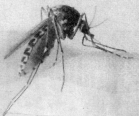
ROSS RIVER VIRUS - RRV
(Epidemic Polyarthritis - EPA)
![]() The Personal, Family, Social and Economic Impacts of Ross River
Virus - EPA
The Personal, Family, Social and Economic Impacts of Ross River
Virus - EPA
Diagnosis
The disease usually develops within 2 days to 3 weeks after being bitten by a mosquito carrying the virus. The common symptoms of the disease are similar to many other conditions so diagnosis can be difficult. A Laboratory diagnosis is required and it is a simple blood test. If you should have many of the common symptoms (particularly, in summer or early autumn or after heavy rain) then request a test. If you feel you may have had the virus previously and are currently or have previously had a reoccurrence get it checked out. You do not have to be in the initial acute infection stage for the disease to be identified. It may also be wise to get checked out for Barmah Forest Virus (BFV) at the same time as it has similar symptoms and is also carried by mosquitoes.
Stages of the disease
It is a disease that has two stages, the first an initial acute infection and the second stage is the chronic stage.
- The initial acute infection stage can last from days to 9-12 months and could go even longer. There appears to be some relationship between the length and severity of the initial acute infection to the length and severity of the chronic stage of the disease.
- The chronic stage periodically produces another acute infection although usually not with all the symptoms of the initial acute infection. The length of time the chronic stage lasts in unknown. However, I know of cases who have had the chronic stage for at least 20 years. There appears to be no consistent time period for reoccurences and these can range from every 4-6 weeks for several years to 3 monthly or even yearly. However, the reoccurences eventually, get further apart. The length of the reoccurence can range from 1-2 days to 3-4 months.
- Note: the fact that someone has had RRV does not mean you are immune from other attacks. I know of some who have had it twice, one who was told had a different strain
Common Symptoms
Those symptoms listed as common are those usually seen in medical handouts and from researching universities and other health related organisations.
- A form of arthritis with pain, tenderness and swelling in the joints. The joints most commonly affected are wrists, fingers, knees, ankles and toes. However, not all of these are always affected.
- It is often accompanied with headaches and tiredness.
- A rash may break out on any part of the body but most commonly on the abdomen, chest, back arms and legs. Not all RRV sufferers develop a rash.
- Fever or chilly sensations (usually slight or absent) and a general feeling of being unwell.
Less Recognised Symptoms
The symptoms listed below are ones that have been experienced by sufferers.
However, most people infected with Ross River Virus will only get some of them.
They are symptoms rarely mentioned from any of the groups mentioned in the above list or
any any literature provided to patients. However, they are symptoms described by
sufferers when talking to another sufferer. (Where I have listed this is rare it is
because I have not heard of very many cases with these symptoms.) Other symptoms that may be identified by the medical profession include: There is very little known about the long term effects of the chronic stage of the
disease. Some that have been identified and may only be experienced by some of the
long term sufferers. At the present time there is no cure or immunisation against the disease. Medically prescribed The most common treatment by the medical profession at the present time are: RRV sufferers consulting each other
Symptoms of Long Term sufferers
(2 years or more)
Treatment
You are the
visitor to this page.
Copyright © 1998 All rights reserved.
This site was created on 5 September 1998
This site was updated: September 1999.
This page hosted by ![]() Get your own Free
Homepage
Get your own Free
Homepage